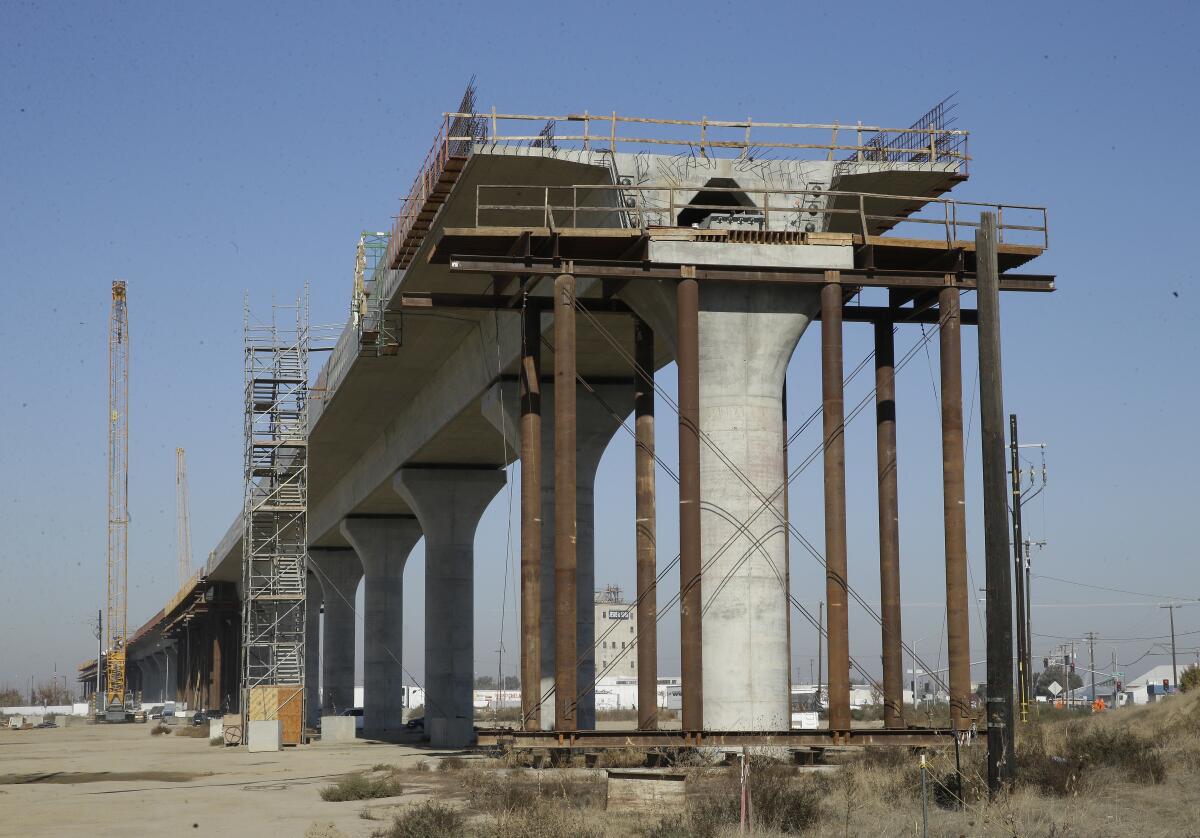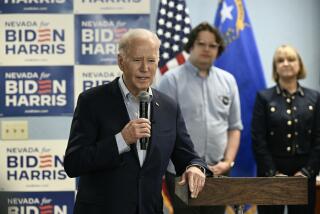Column: A lot of Californians think the bullet train’s a pipe dream. The rail authority’s head disagrees

Few topics in California elicit more heated responses than the long-suffering California high speed rail project, and my Wednesday column got the corn popping.
After years of delays, massively increased cost projections, lawsuits, conflict of interest probes, well-chronicled ineptitude and nothing but mystery as to how we’ll ever have the money to complete it, many people who voted for the bullet train ballot proposition in 2008 now call the whole thing a boondoggle and a disaster.
Think Hindenburg, one reader said, or Titanic. “Let’s get out while we can,” he warned.
My column threw support behind a proposal by several legislators to take some of the money being sunk into construction of a line between Bakersfield and Madera in the Central Valley, and instead use it to fortify rail service in the far more populous Bay Area and Southern California. Building a high speed system from the bookends toward the center of the state, I said, makes more sense than starting in the middle.
One reader said I’m living in the Twilight Zone if I think there’s any way we’ll ever see high speed trains running that entire length of the planned route. But others argued that California, a climate change leader, has to get this done — one way or another — because it might pry some people out of their cars.
Another reader wondered why so many other countries have been able to build high speed rail without controversy. And a Fresno resident pushed back against a shifting of funds to L.A. and S.F., accusing me of treating the middle of the state as flyover country.
And then there was one email in particular that grabbed my attention. It was from the guy who’s running the railroad.
If you’ve ever been on a golf course driving range, you may have noticed the guy in the caged tractor who motors about, retrieving balls while golfers shoot missiles in his direction. I figure Brian Kelly’s job must feel a little bit like that, except there’s no cage for the executive director of the California High Speed Rail Authority.
“We’re making progress in the [Central] Valley at a much greater pace than we were before. None of that gets talked about,” said Kelly, who complained that the focus is on “yesterday’s problems.”
Some would dispute those claims, but Kelly does make some good points.
My Wednesday column came in the wake of a story by my colleague Ralph Vartabedian about the fact that Kelly and company were pushing ahead with a 30-year construction and maintenance contract despite numerous objections, including from the Federal Railroad Administration.
“This is the Donald Trump Federal Railroad Administration that is taking action against blue states all around the country on transportation projects,” Kelly said.
No doubt, but I noted that the authority’s own peer review panel had reservations, too, about getting locked into a 30-year deal.
Kelly said he worries that the federal government, which wants the project to begin in the center of the state, will try to claw back federal money if the project doesn’t move forward and meet federally imposed deadlines.
Kelly rejected the idea by Assembly Speaker Anthony Rendon (D-Lakewood), Assemblywoman Laura Friedman (D-Glendale) and Assemblyman Tom Daly (D-Anaheim) to move high speed funding out of the San Joaquin Valley and spend it on needed upgrades for existing rail in the state’s population centers. One study suggested that with such a shift ridership between Burbank and Anaheim could double, traffic could be relieved and air quality improved with upgrades funded by high speed rail money.
The legislators aren’t recommending abandoning construction in the Central Valley; they’re just saying that the expensive electrification of tracks for high speed travel doesn’t need to happen now. Friedman argued that trains could still run as fast as 130 mph through the valley.
Kelly bristled at these suggestions, saying promises have been made to the San Joaquin Valley and must be kept.
Actually, the promise was to complete 119 miles of track. But the 30-year contract would lock the rail authority into a major commitment at a time when future funding is in grave doubt. That’s a long time, and what if the technology improves but we’re locked into something inferior?
Kelly said it would be “patently wrong” to run diesel trains, rather than cleaner electrified coaches, through a region of “rampant poverty and terrible air quality.”
I admire Kelly’s loyalty to the Central Valley and his idealism about state-of-the-art rail. I also enjoyed talking to him about the merits of thinking about high speed rail not just in terms of transportation, but as the spine of what — in the outer reaches of the imagination — could be the centerpiece of a massive 400-mile-long affordable housing and economic development corridor that addresses the state’s most pressing challenges.
But if we can’t even budget getting the train from L.A. to San Francisco, I don’t know how we’d pay for that trip to the moon. So I still say that while it might be nice to have people traveling at 200 mph between Bakersfield and Madera, I’m not sure that’s a smart way to spend the money or to elevate the chance of eventually building the entire line, north to south.
Here’s how Rendon sees it: “Yeah, we made promises to the Central Valley, and in the long run we have to work to come through on those promises,” he told me. “That being said, the project right now is quite honestly nowhere, and we run the risk of having nothing.”
Rendon said the idea for moving high speed rail money to San Francisco and Los Angeles came to him a year and a half ago after meeting with an official from the French rail system. He said the official, without knowing the details of our strategy, applauded California’s efforts to build high speed rail and said it always makes sense to link areas of 5 million or more people.
Rendon said the Frenchman’s face fell when the assemblyman explained we had not started in the population centers, but in farm country. Rendon became all the more convinced that if we’re ever going to have a high speed rail system in California, the place to start is where the majority of people live, work, and need better options for getting around.
“Quite honestly, if this was on the ballot for voters to reapprove it based on the existing initial phase, there’s no way voters would approve that,” said Rendon. “People feel this is a stalled project.”
If, by some miracle, we one day figure out how to build the whole thing, good for us.
But in a state of 40 million residents, we are building high speed rail in a region where about 4 million people live, and we may never get further than that.
Like I said Wednesday regarding the proposal to move some money to where it can benefit more people — I’m on board.
Steve.lopez@latimes.com
More to Read
Start your day right
Sign up for Essential California for news, features and recommendations from the L.A. Times and beyond in your inbox six days a week.
You may occasionally receive promotional content from the Los Angeles Times.






